翻译常用之八大技negation
- 格式:ppt
- 大小:242.50 KB
- 文档页数:9
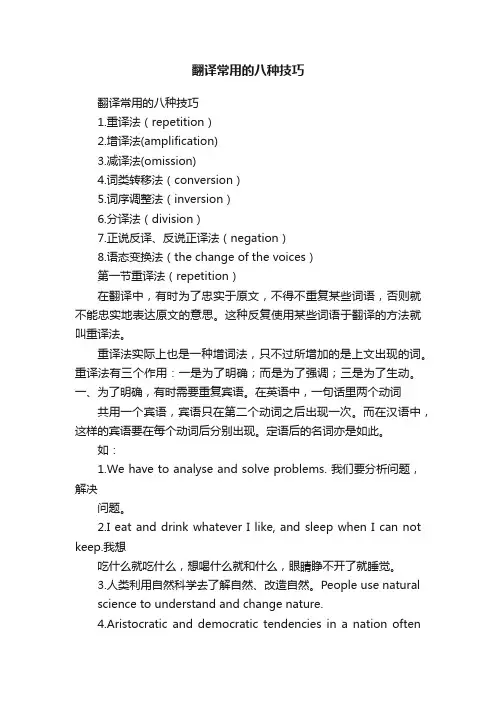
翻译常用的八种技巧翻译常用的八种技巧1.重译法(repetition)2.增译法(amplification)3.减译法(omission)4.词类转移法(conversion)5.词序调整法(inversion)6.分译法(division)7.正说反译、反说正译法(negation)8.语态变换法(the change of the voices)第一节重译法(repetition)在翻译中,有时为了忠实于原文,不得不重复某些词语,否则就不能忠实地表达原文的意思。
这种反复使用某些词语于翻译的方法就叫重译法。
重译法实际上也是一种增词法,只不过所增加的是上文出现的词。
重译法有三个作用:一是为了明确;而是为了强调;三是为了生动。
一、为了明确,有时需要重复宾语。
在英语中,一句话里两个动词共用一个宾语,宾语只在第二个动词之后出现一次。
而在汉语中,这样的宾语要在每个动词后分别出现。
定语后的名词亦是如此。
如:1.We have to analyse and solve problems. 我们要分析问题,解决问题。
2.I eat and drink whatever I like, and sleep when I can not keep.我想吃什么就吃什么,想喝什么就和什么,眼睛睁不开了就睡觉。
3.人类利用自然科学去了解自然、改造自然。
People use naturalscience to understand and change nature.4.Aristocratic and democratic tendencies in a nation oftenshowthemselves in its speech.民族的贵族倾向和民族倾向常在其言语中表现出来。
5.我们来修改安全规则和卫生规则吧。
Let’s revise our safety andsanitary regulations.二、英语常用省略,但为了明确,也为了强调某些内容,在汉语中常常要将省去的部分重译出来。
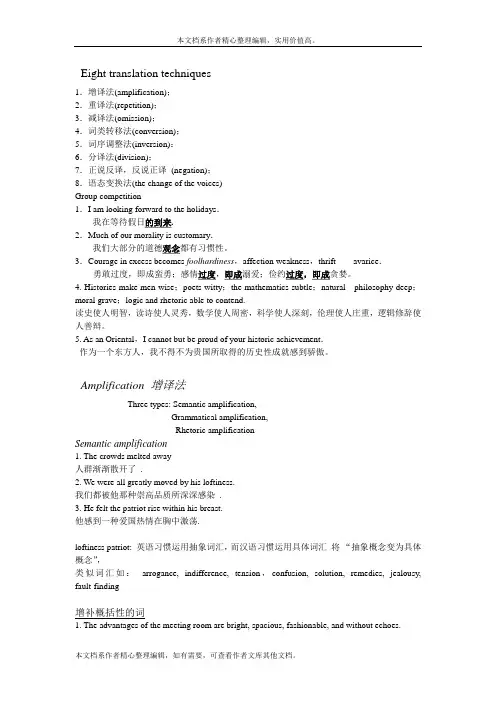
Eight translation techniques1.增译法(amplification);2.重译法(repetition);3.减译法(omission);4.词类转移法(conversion);5.词序调整法(inversion):6.分译法(division);7.正说反译,反说正译(negation);8.语态变换法(the change of the voices)Group competition1.I am looking forward to the holidays.我在等待假日的到来.2.Much of our morality is customary.我们大部分的道德观念都有习惯性。
3.Courage in excess becomes foolhardiness,affection weakness,thrift avarice.勇敢过度,即成蛮勇;感情过度,即成溺爱;俭约过度,即成贪婪。
4. Histories make men wise;poets witty;the mathematics subtle;natural philosophy deep;moral grave;logic and rhetoric able to contend.读史使人明智,读诗使人灵秀,数学使人周密,科学使人深刻,伦理使人庄重,逻辑修辞使人善辩。
5. As an Oriental,I cannot but be proud of your historic achievement.作为一个东方人,我不得不为贵国所取得的历史性成就感到骄傲。
Amplification 增译法Three types: Semantic amplification,Grammatical amplification,Rhetoric amplificationSemantic amplification1. The crowds melted away人群渐渐散开了.2. We were all greatly moved by his loftiness.我们都被他那种崇高品质所深深感染.3. He felt the patriot rise within his breast.他感到一种爱国热情在胸中激荡.loftiness patriot: 英语习惯运用抽象词汇,而汉语习惯运用具体词汇将“抽象概念变为具体概念”,类似词汇如:arrogance, indifference, tension,confusion, solution, remedies, jealousy, fault-finding增补概括性的词1. The advantages of the meeting room are bright, spacious, fashionable, and without echoes.这个会议室有四大优点:明亮、宽敞、时髦、无回声。
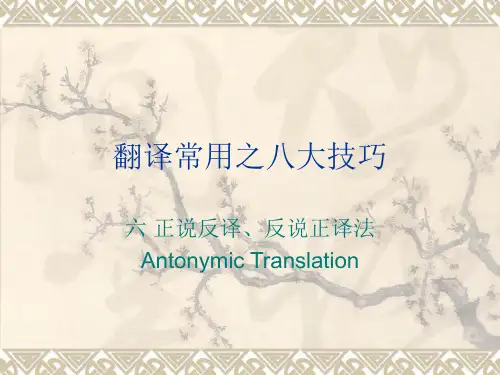

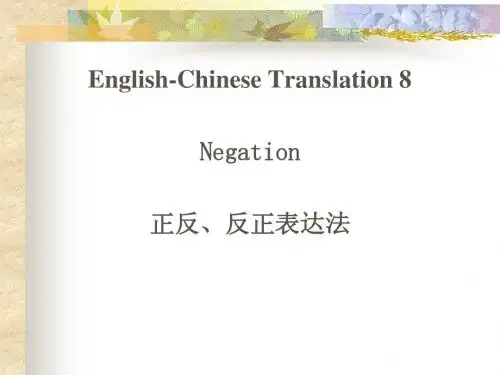
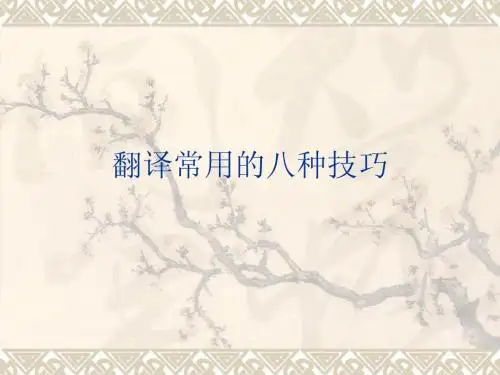
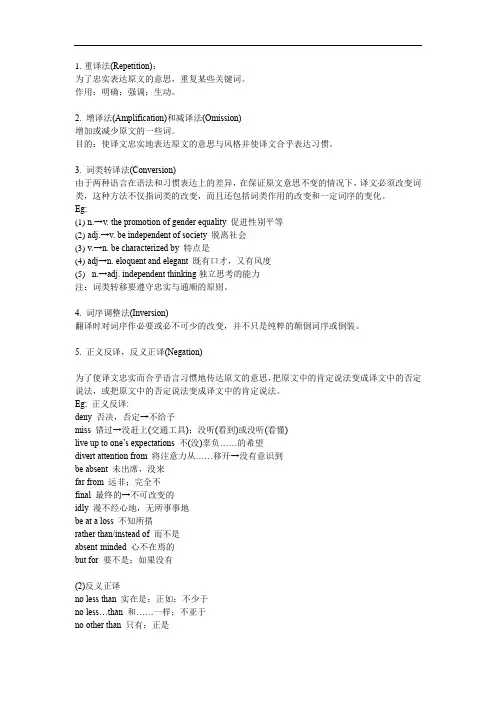
1.重译法(Repetition):为了忠实表达原文的意思,重复某些关键词。
作用:明确;强调;生动。
2. 增译法(Amplification)和减译法(Omission)增加或减少原文的一些词。
目的:使译文忠实地表达原文的意思与风格并使译文合乎表达习惯。
3. 词类转译法(Conversion)由于两种语言在语法和习惯表达上的差异,在保证原文意思不变的情况下,译文必须改变词类,这种方法不仅指词类的改变,而且还包括词类作用的改变和一定词序的变化。
Eg:(1)n.→v. the promotion of gender equality 促进性别平等(2)adj.→v. be independent of society 脱离社会(3)v.→n. be characterized by 特点是(4)adj→n. eloquent and elegant 既有口才,又有风度(5)n.→adj. independent thinking独立思考的能力注:词类转移要遵守忠实与通顺的原则。
4. 词序调整法(Inversion)翻译时对词序作必要或必不可少的改变,并不只是纯粹的颠倒词序或倒装。
5. 正义反译,反义正译(Negation)为了使译文忠实而合乎语言习惯地传达原文的意思,把原文中的肯定说法变成译文中的否定说法,或把原文中的否定说法变成译文中的肯定说法。
Eg: 正义反译:deny 否决,否定→不给予miss 错过→没赶上(交通工具);没听(看到)或没听(看懂)live up to one’s expectations 不(没)辜负……的希望divert attention from 将注意力从……移开→没有意识到be absent 未出席,没来far from 远非;完全不final 最终的→不可改变的idly 漫不经心地,无所事事地be at a loss 不知所措rather than/instead of 而不是absent-minded 心不在焉的but for 要不是;如果没有(2)反义正译no less than 实在是;正如;不少于no less…than 和……一样;不亚于no other than 只有;正是none other than (用以加强语气) 正是,恰恰是,不是别人,正是……nothing but 只有(是);只不过no choice but 别无选择,只(好)得unfold 展开,呈现disappear 消失,失踪carelessly 马马虎虎地,粗心地6. 分译法(Division)分译法主要用于长句的翻译。
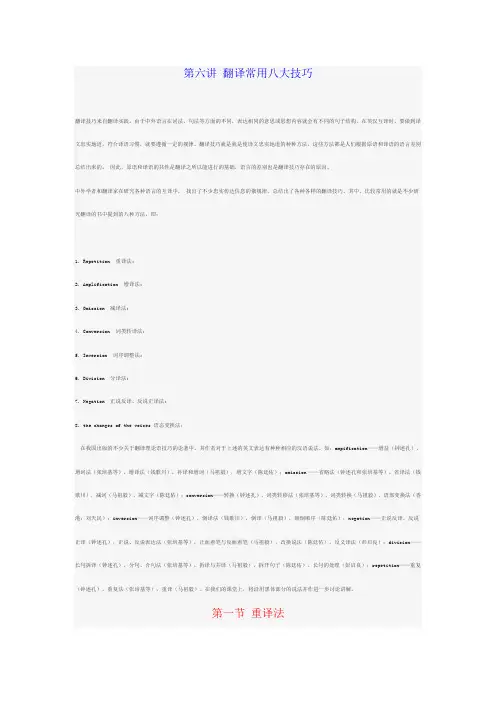
第六讲翻译常用八大技巧翻译技巧来自翻译实践。
由于中外语言在词法、句法等方面的不同,表达相同的意思或思想内容就会有不同的句子结构。
在英汉互译时,要做到译文忠实地道,符合译语习惯,就要遵循一定的规律。
翻译技巧就是就是使译文忠实地道的种种方法,这些方法都是人们根据原语和译语的语言差别总结出来的。
因此,原语和译语的共性是翻译之所以能进行的基础,语言的差别也是翻译技巧存在的原因。
中外学者和翻译家在研究各种语言的互译中,找出了不少忠实传达信息的俄规律,总结出了各种各样的翻译技巧。
其中,比较常用的就是不少研究翻译的书中提到的八种方法,即:1. Repetition 重译法;2. Amplification 增译法;3. Omission 减译法;4. Conversion 词类转译法;5. Inversion 词序调整法;6. Division 分译法;7. Negation 正说反译、反说正译法;8. the changes of the voices 语态变换法;在我国出版的不少关于翻译理论语技巧的论著中,其作者对于上述的英文表达有种种相应的汉语说法。
如:ampification——增益(钟述孔),增词法(张培基等),增译法(钱歌川),补译和增词(马祖毅),增文字(陈廷佑);omission ——省略法(钟述孔和张培基等),省译法(钱歌川),减词(马祖毅),减文字(陈廷佑);conversion——转换(钟述孔),词类转移法(张培基等),词类转换(马祖毅),语部变换法(香港:刘天民);inversion——词序调整(钟述孔),倒译法(钱歌川),倒译(马祖毅),颠倒顺序(陈廷佑);negation——正说反译、反说正译(钟述孔),正说、反说表达法(张培基等),正面着笔与反面着笔(马祖毅),改换说法(陈廷佑),反义译法(彭启良);division——长句拆译(钟述孔),分句、合句法(张培基等),拆译与并译(马祖毅),拆开句子(陈廷佑),长句的处理(彭启良);repetition——重复(钟述孔),重复法(张培基等),重译(马祖毅)。
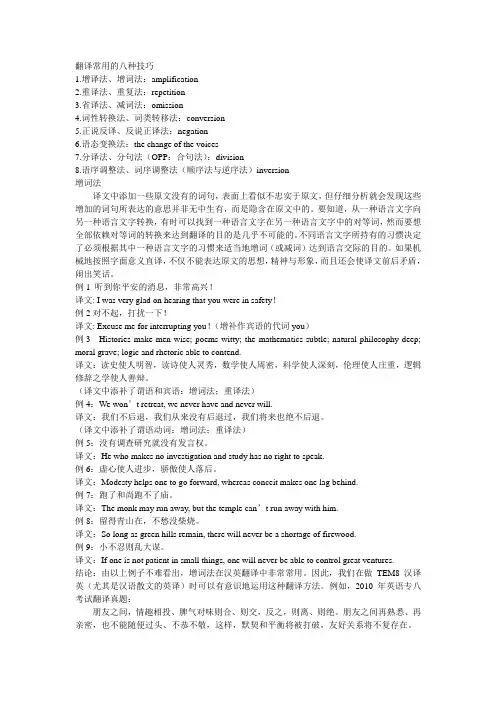
翻译常用的八种技巧1.增译法、增词法:amplification2.重译法、重复法:repetition3.省译法、减词法:omission4.词性转换法、词类转移法:conversion5.正说反译、反说正译法:negation6.语态变换法:the change of the voices7.分译法、分句法(OPP:合句法):division8.语序调整法、词序调整法(顺序法与逆序法)inversion增词法译文中添加一些原文没有的词句,表面上看似不忠实于原文,但仔细分析就会发现这些增加的词句所表达的意思并非无中生有,而是隐含在原文中的。
要知道,从一种语言文字向另一种语言文字转换,有时可以找到一种语言文字在另一种语言文字中的对等词,然而要想全部依赖对等词的转换来达到翻译的目的是几乎不可能的。
不同语言文字所持有的习惯决定了必须根据其中一种语言文字的习惯来适当地增词(或减词)达到语言交际的目的。
如果机械地按照字面意义直译,不仅不能表达原文的思想,精神与形象,而且还会使译文前后矛盾,闹出笑话。
例1 听到你平安的消息,非常高兴!译文: I was very glad on hearing that you were in safety!例2对不起,打扰一下!译文: Excuse me for interrupting you!(增补作宾语的代词you)例3 Histories make men wise; poems witty; the mathematics subtle; natural philosophy deep; moral grave; logic and rhetoric able to contend.译文:读史使人明智,读诗使人灵秀,数学使人周密,科学使人深刻,伦理使人庄重,逻辑修辞之学使人善辩。
(译文中添补了谓语和宾语:增词法;重译法)例4:We won’t retreat, we never have and never will.译文:我们不后退,我们从来没有后退过,我们将来也绝不后退。
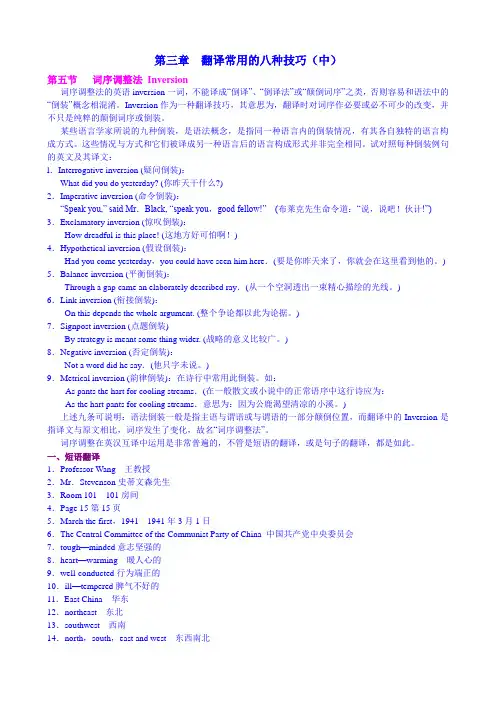
第三章翻译常用的八种技巧(中)第五节词序调整法Inversion词序调整法的英语inversion一词,不能译成“倒译”、“倒译法”或“颠倒词序”之类,否则容易和语法中的“倒装”概念相混淆。
Inversion作为一种翻译技巧,其意思为,翻译时对词序作必要或必不可少的改变,并不只是纯粹的颠倒词序或倒装。
某些语言学家所说的九种倒装,是语法概念,是指同一种语言内的倒装情况,有其各自独特的语言构成方式。
这些情况与方式和它们被译成另一种语言后的语言构成形式并非完全相同。
试对照每种倒装例句的英文及其译文:l.Interrogative inversion (疑问倒装):What did you do yesterday? (你昨天干什么?)2.Imperative inversion (命令倒装):“Speak you,” said Mr.Black, “speak you,good fellow!” (布莱克先生命令道:“说,说吧!伙计!”) 3.Exclamatory inversion (惊叹倒装):How dreadful is this place! (这地方好可怕啊!)4.Hypothetical inversion (假设倒装):Had you come yesterday,you could have seen him here.(要是你昨天来了,你就会在这里看到他的。
) 5.Balance inversion (平衡倒装):Through a gap came an elaborately described ray.(从一个空洞透出一束精心描绘的光线。
)6.Link inversion (衔接倒装):On this depends the whole argument. (整个争论都以此为论据。
)7.Signpost inversion (点题倒装)By strategy is meant some thing wider. (战略的意义比较广。
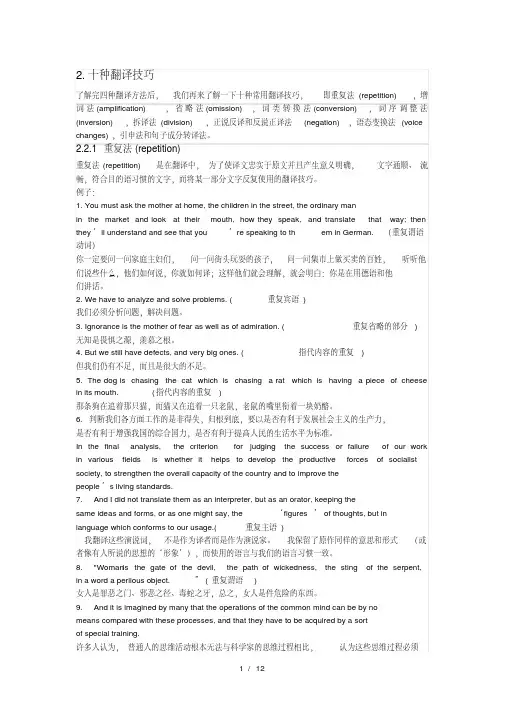
2.十种翻译技巧了解完四种翻译方法后,我们再来了解一下十种常用翻译技巧,即重复法(repetition),增词法(amplification),省略法(omission),词类转换法(conversion),词序调整法(inversion),拆译法(division),正说反译和反说正译法(negation),语态变换法(voice changes),引申法和句子成分转译法。
2.2.1重复法(repetition)重复法(repetition)是在翻译中,为了使译文忠实于原文并且产生意义明确,文字通顺、流畅,符合目的语习惯的文字,而将某一部分文字反复使用的翻译技巧。
例子:1. You must ask the mother at home, the children in the street, the ordinary manin the market and look at their mouth, how they speak, and translate that way; then they’ll understand and see that you’re speaking to th em in German. (重复谓语动词)你一定要问一问家庭主妇们,问一问街头玩耍的孩子,问一问集市上做买卖的百姓,听听他们说些什么,他们如何说,你就如何译;这样他们就会理解,就会明白:你是在用德语和他们讲话。
2. We have to analyze and solve problems. (重复宾语)我们必须分析问题,解决问题。
3. Ignorance is the mother of fear as well as of admiration. (重复省略的部分) 无知是畏惧之源,羡慕之根。
4. But we still have defects, and very big ones. (指代内容的重复)但我们仍有不足,而且是很大的不足。
NegationIt is widely acknowledged that English and Chinese are totally different resulting from thousands of years of separation. Hence, a lot of attention must be paid to translating English sentences when we imply translation skills; suspended at the top of the list, as far as I am concerned, is negation. It is my own belief that a man who know little about the negation in English expression is liable to misunderstand the sentence, what is worse, you may get the utterly opposite idea. Therefore, I would like to analyse the negation in translation in the following aspects.To start with, a negative, in translation, may be transferred from one place to another. For example, we prefer to say “I don’t think he will win” rather than say “I think he will not win”. However, in Chinese, “我不认为他会赢” should give way to “我认为他不会赢”. In this sentence, the negative transfers from the main clause to the subordinate that-clause. Besides, the negative can be transfered in two more cases. For one thing, it can transfer from the finite verb to the adverbial, especially in adverbial clause of cause, eg: He did not come because he wanted to see me.(他来并不是因为想见我) For another, it can transfer to the verb from the other parts of the sentence.In addition, partial negation is another thing we should pay attention to. There are several patterns of partial negation, such as partial affirmative + not, not + full negative, not for nothing, etc. Take a sentence for example, “all men are not born to reign” means “not all men are born to reign”, in other words, some men are born to reign. While full negation is the traditional nagation which we are not likely to misconceive the meaning.When this kinds of sentences are confronted, what is needed is a realization that “no” is much stronger and consequently more emphatic than “not”.What is more, double negation amounts to affirmation. Double negation has two distinct forms: one indicating euphemism and the other emphasis. In the former, we weaken the statement; while in the latter, we strengthen it. Both of them can be translated in an affirmative tone. “Nothing is impossible to a willing mind(有志者,事竟成)” can illustrate this point very well.Furthermore, there are several invisible negative patterns. For example,“If only I met you”means “I haven’t met you”, “This is more than I can say” means “I cann’t say it in words”. Some euphemistic affirmation is equivalent to negation, eg: All music is alike to Tom, in other words, Tom is incapable of appreciating music. Some affirmative idioms also express negative meaning, for instance, “I will buy it” means “I have no idea”.Last but not least, we should take great caution in translating sentences which have negative phrases but express affirmative meaning. Eg. (1)The family were nothing if not happy(the family were fairly happy). (2)We can’t recommend this book strongly enough(we should recommend this book strongly).。
考试复习一、英汉互译下列习语(每小题2分,共20分)书上或日常生活中常出现的一些习语或成语。
二、将下列句子翻译成中文,并指出使用的翻译技巧(每小题3分,共30分)翻译常见的八种技巧:1.重复repetition在翻译中被称为一种技巧,自然就不是一般所说的不必要的重复,而是一种必不可少的方法。
可以这样确定它的定义:在翻译中,有时为了忠实于原文,不得不重复某些词语,否则就不能忠实表达原文的意思。
这种反复使用某些词语于翻译的方法就叫重译法。
一般说来,重译法有如下三个作用:一是为了明确;二是为了强调;三是为了生动。
We have to analyze and solve problems.我们要分析问题,解决问题。
2.增译addition/amplification什么叫增译法我们可以这样确定它的定义:为了使译文忠实地表达原文的意思与风格并使译文合乎表达习惯,必须增加一些词语,这就叫增译法。
送君千里,终有一别。
,yet the parting must come at last.3.减译法deletion和其他一切事物一样,翻译也是有增必有减。
懂了增译法之后自然也就会懂得什么是减译法。
它是增译法的反面:以同一个译例来说,在英译汉中如果用增译法的话,在汉译英中自然就要用减译法了。
把第二节中的31个例子倒译的话(即把汉译英改为英译汉或把英译汉变为汉译英),所用的译法就不是增译法而是减译法了。
关于减译法,应该记住这样一条总原则:减译法是指原文中有些词在译文中不译出来,因为译文中虽无其词而已有其意,或者在译文中是不言而喻的;换言之,减译法是删去一些可有可无的,或者有了反嫌累赘或违背译文习惯表达法的词,但减译并不是把原文的某些思想内容删去。
此外,冠词、连词、代词(尤其是人称代词、关系代词)、关系副词,等等,在英语中经常使用,但译成汉语时几乎很少出现,要使译文忠实而地道,减译法就自然必不可少了。
例如:A book is useful.书(是)有用(的)。
2.十种翻译技巧了解完四种翻译方法后,我们再来了解一下十种常用翻译技巧,即重复法(repetition),增词法(amplification),省略法(omission),词类转换法(conversion),词序调整法(inversion),拆译法(division),正说反译和反说正译法(negation),语态变换法(voice changes),引申法和句子成分转译法。
2.2.1重复法(repetition)重复法(repetition)是在翻译中,为了使译文忠实于原文并且产生意义明确,文字通顺、流畅,符合目的语习惯的文字,而将某一部分文字反复使用的翻译技巧。
例子:1. You must ask the mother at home, the children in the street, the ordinary man in the market and look at their mouth, how they speak, and translate that way; then they’ll understand and see that you’re speaking to them in German. (重复谓语动词)你一定要问一问家庭主妇们,问一问街头玩耍的孩子,问一问集市上做买卖的百姓,听听他们说些什么,他们如何说,你就如何译;这样他们就会理解,就会明白:你是在用德语和他们讲话。
2. We have to analyze and solve problems. (重复宾语)我们必须分析问题,解决问题。
3. Ignorance is the mother of fear as well as of admiration. (重复省略的部分) 无知是畏惧之源,羡慕之根。
4. But we still have defects, and very big ones. (指代内容的重复)但我们仍有不足,而且是很大的不足。